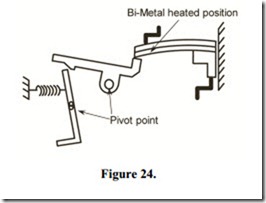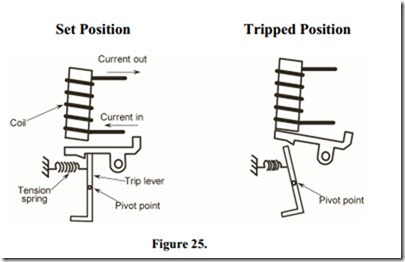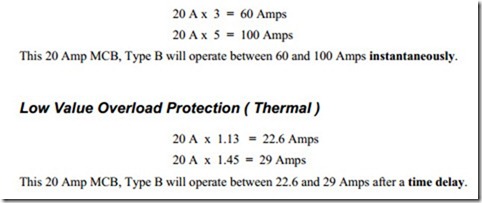Miniature Circuit Breakers
The MCB ( miniature circuit breaker ) is an automatic switch which operates when excess current passes through it. The MCB can be closed again, because the device does not damage itself during normal operation. The contacts of a circuit breaker are closed against spring pressure, and held closed by a latch arrangement. A small movement of the latch will release the contacts, which open quickly under spring pressure to break the circuit. This operation can be compared to that of a mouse trap.
Figure 21 shows the “trip mechanism” of a MCB in the “on” or “set” position.
The circuit breaker is so arranged that normal currents will not affect the trip lever, whereas excessive currents will move it, to operate the breaker. There are two basic methods by which overcurrents can operate the trip lever.
Thermal Tripping
The load current is passed through a bi-metal strip. This bi-metal strip consists of two different metals. These metals are fixed together throughout their length. The rate of expansion of the two metals is different. As the bi-metal strip heats up, it will bend towards the trip lever.
The temperature of the bi-metal strip depends on the current it carries. The rated current of the MCB will not heat the bi-metal strip sufficiently to cause tripping. When an overcurrent occurs, the bi-metal strip temperature increases. After a time delay the bi-metal strip bends far enough to operate the trip lever.
The time delay in the operation of a thermal device will depend on the value of the overcurrent flowing through it. The heat produced by the load current must be transferred to the bi-metal strip. Thermal tripping devices are thus best suited to low value overloads of comparatively long duration. They cannot respond fast enough to high value overloads or short circuits.
Magnetic tripping
The MCB also uses the magnetic effect of an electric current.
A coil of a suitable diameter and length of wire for the rated current of the MCB is arranged so that the circuit current flows through it. This current produces a magnetic field around the coil. This magnetic field attracts the MCB latch mechanism. The magnetic field strength will depend on the value of current flowing through the coil.
A current value of up to three times the rated current of the device must not produce a strong enough magnetic field to attract the latch. A current value in excess of three times the rated current of the device may attract the latch. A current value of five times the rated current of the device must attract the latch. These figures are for a Type B MCB. This in turn releases the trip lever, disconnecting the supply from the load.
Figure 25 illustrates the principle of operation of the Magnetic-Overload Trip. The “set” and “tripped” positions are shown.
Magnetic trips are fast acting for heavy overloads and / or short circuits, but are uncertain in operation for light overloads.
Thermal and magnetic components are thus combined in MCB’s to take advantage of their best characteristics.
Functions of an MCB
· To carry full rated current safely without tripping, or overheating.
· To detect sustained overloads and short circuits and thereby protect the installation.
· To tolerate harmless or momentary overloads.
A secondary function of the MCB is that it can be used as a switch for the circuit. Consequently an MCB offers control, protection and isolation.
Advantages of an MCB
· Automatically trips out under fault conditions.
· Cannot manually be held “on” under fault conditions.
· Enables supply to be restored immediately after fault is cleared.
· Enables faulty circuit to be easily identified.
· May be used as a switch to control the circuit.
· Does not age in service.
· Gives accurate protection and is tamper proof.
· Can be mounted in attractive assemblies.
· Domestic pattern is of uniform size regardless of current rating.
· Tolerates transient overloads.
· May be used as an isolator.
Types of MCB
MCB’s are manufactured in a range of types. The main types now recommended are denoted by the letters B, C and D. Other special types are denoted by the letters K and Z.
Some older types of MCB are denoted by the numerals 1,2,3 or by the letters L,G and U. MCB’s are manufactured in such a way that they have different characteristics. Type B has a
different characteristic to type C, while Type C has a different characteristic to Type D and so on.
At this stage of the Phase 2 Training Programme, we will deal with Type B, as it is the recommended type for use in domestic situations.
The Type B characteristic stipulates that the MCB must trip magnetically between 3 and 5 times its rated current, and it must trip thermally between 1.13 and 1.45 times its rated current.
Example: A 20 Amp MCB Type B will operate as follows:
Short Circuit and High Value Overload Protection ( Magnetic )
This 20 Amp MCB, Type B will operate between 22.6 and 29 Amps after a time delay.
To this end, manufacture’s provide tripping characteristic graphs, which show load current on the horizontal axis and tripping time on the vertical axis. From these graphs one can check, how long it will take an MCB to trip for a given value of overcurrent.
The characteristic of a Type B MCB is such that it provides protection of cables supplying resistive loads. It is not suitable for use where switching surges are a factor e.g. starting of electric motors.





